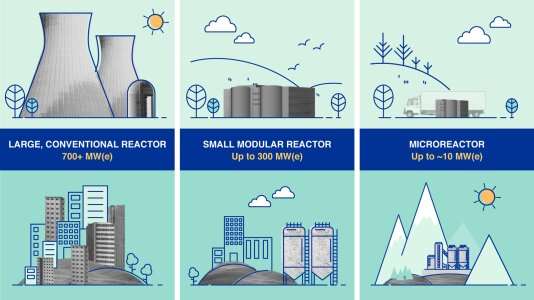Argonne releases small modular reactor waste analysis report

Study one of the first to address nuclear waste production of small modular reactors.
Nuclear energy is a key component of decarbonizing our economy, but large nuclear reactors are often complicated and expensive to build. To make nuclear energy more available and attractive, developers have put forward multiple designs of small modular reactors (SMRs) that have greater flexibility and offer lower up-front costs. Different types of SMRs with advanced reactor design features are currently under development in the United States and worldwide.
Researchers believe SMRs could be deployed at a variety of scales for locally distributed electricity generation. SMRs have approximately a tenth to a third of the power output of large light water reactors, which are the most common kind of nuclear reactor in commercial operation in the United States. The technologies and economics of SMRs have been widely studied; however, there is less information about their implications for nuclear waste. "We've really just begun to study the nuclear waste attributes of SMRs," said senior nuclear engineer Taek Kyum Kim of the U.S. Department of Energy's (DOE) Argonne National Laboratory.
Kim and his colleagues from Argonne and DOE's Idaho National Laboratory have recently published a report that endeavors to measure the potential nuclear waste attributes of three different SMR technologies using metrics developed through an extensive process during a comprehensive assessment of nuclear fuel cycles published in 2014. Although SMRs are not yet in commercial operation, several companies have collaborated with the DOE to explore different possibilities for SMRs, and the three designs studied in the report are all scheduled to be constructed and operational by the end of the decade.
One type of SMR, called VOYGR and in development by NuScale Power, is based on a current conventional pressurized water reactor design but scaled down and modularized. Another type, called Natrium and being developed by TerraPower, is sodium-cooled and runs on a metallic fuel. A third type, called the Xe-100 and developed by X-energy, is cooled by helium gas.
In terms of nuclear waste, each reactor offers both advantages and disadvantages over large LWRs, Kim said. "It's not correct to say that because these reactors are smaller they will have more problems proportionally with nuclear waste, just because they have more surface area compared to the core volume," he said. "Each reactor has pluses and minuses that depend upon the discharge burnup, the uranium enrichment, the thermal efficiency and other reactor-specific design features."
One notable factor that influences the amount of nuclear waste produced by a reactor is called burnup, and it refers to the amount of thermal energy produced from a certain quantity of fuel. The Natrium and Xe-100 reactors have significantly higher burnup than LWRs, Kim said. A higher burnup is correlated with lower nuclear waste production because fuel is converted more efficiently to energy. These designs also have higher thermal efficiency, which refers to how efficiently the heat produced by the reactor is converted into electricity. The VOYGR pressurized water reactor design, due in part to its small size, has a slightly lower burnup and thermal efficiency compared to a larger pressurized water reactor.
The spent fuel attributes vary somewhat between the designs, with VOYGR being similar to LWRs, Natrium producing a more concentrated waste with different long-lived isotopes, and Xe-100 producing a lower density but larger volume of spent fuel.
"All told, when it comes to nuclear waste, SMRs are roughly comparable with conventional pressurized water reactors, with potential benefits and weaknesses depending on which aspects you are trying to design for," Kim said. "Overall, there appear to be no additional major challenges to the management of SMR nuclear wastes compared to the commercial-scale large LWR wastes."

















